PLANT TISSUES
- The study of the internal structure of plants is known as anatomy.
- Plants are composed of cells, which organize into tissues, and these tissues further form organs.
- Plant tissues are groups of cells with similar structures and functions.
- Two broad categories of plant tissues are meristematic and permanent tissues.
- Variations exist in the internal structures of different plant organs.
- Adaptations to various environments are evident in plant internal structures.
- In angiosperms, monocots and dicots exhibit anatomical differences.
Meristematic tissues
- Meristematic tissues are regions of actively dividing cells responsible for plant growth.
Types:
1. Apical Meristem:
Found at the tips of stems and roots.
Responsible for primary growth in length.
2. Lateral Meristem:
Located in the lateral (side) regions of stems and roots.
Responsible for secondary growth in thickness.
3. Intercalary Meristem:
Occurs at the base of leaf blades and internodes (stem segments).
Facilitates regrowth after damage.
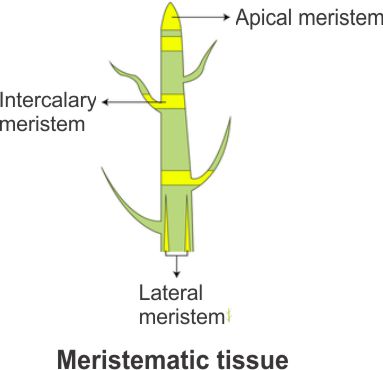
- Characteristics:
- Meristematic tissues are small, isodiametric (similar in all dimensions) cells.
- They show rapid cell division.
- Lack of differentiation (cells remain undifferentiated).
- Functions:
- Meristematic tissues help in primary growth in length.
- By these tissues formation of new leaves, stems, and roots occurs.
- They are responsible for wound healing and regeneration.
Permanent Tissues:
- Permanent tissues are composed of mature cells that have lost their ability to divide.
- Types:
- Simple Permanent Tissues: Consists of only one type of cell.
1. Parenchyma:
Parenchyma cells are thin-walled cells with large central vacuoles.
They are involved in photosynthesis, storage, and healing.
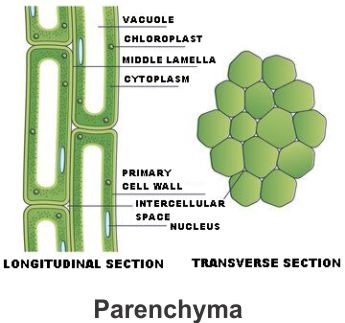
2. Collenchyma:
Cells with irregularly thickened cell walls.
Collenchyma provides support to growing plant parts.
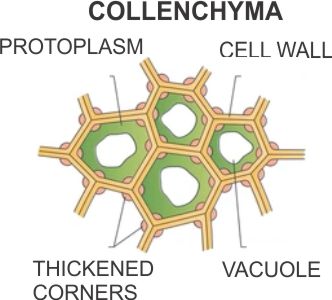
3. Sclerenchyma:
Cells of sclerenchyma have heavily thickened walls.
They enhance mechanical support and rigidity.
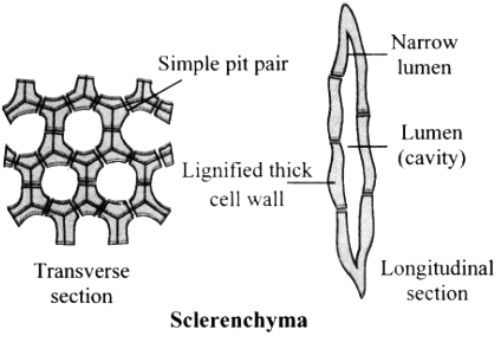
- Complex Permanent Tissues: Combinations of different cell types.
1. Xylem: Conducts water and minerals from roots to leaves.
Components of xylem-
Tracheids:
- They are long, tapering cells with thick lignified walls.
- They are responsible for water transport.
Vessel Elements:
- They are wider, shorter cells with perforated end walls.
- They are efficient water-conducting elements.
Xylem Parenchyma:
- Xylem parenchyma are thin-walled, living cells.
- Functions in storage and lateral conduction of water.
- It plays a role in repairing damaged xylem.
Xylem Fibers:
- Xylem fibres are long, thick-walled cells with tapering ends.
- They Provide mechanical support and rigidity to the plant.
- They are mostly dead at maturity.
Xylem Sap:
- Xylem sap is composed of water and dissolved minerals (mainly ions).
- It moves from roots to leaves, providing hydration and nutrients.
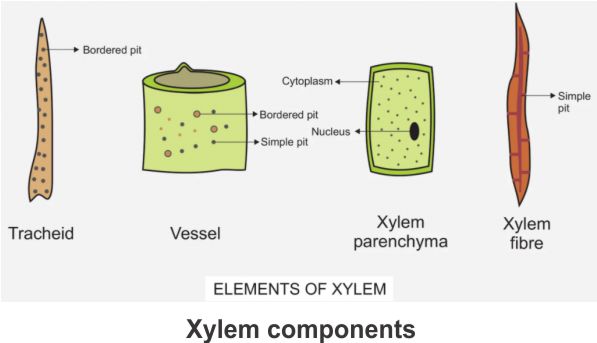
2. Phloem: Transports nutrients (mainly sugars) throughout the plant.
Components of phloem-
Sieve Tubes:
- Sieve tubes are elongated cells arranged end to end.
- They have perforated sieve plates at their ends.
- They are responsible for transporting nutrients (mainly sugars) throughout the plant.
Companion Cells:
- Companion cells are found alongside sieve tubes.
- They assist in the loading and unloading of sugars into and out of sieve tubes.
- They are connected to sieve tubes via plasmodesmata.
Phloem Parenchyma:
- Phloem parenchyma are thin-walled living cells.
- Their function is in the storage and lateral transport of nutrients.
- They can differentiate into companion cells when needed.
Phloem Fibers:
- Phloem fibers provide mechanical support to the phloem.
- It is made up of thick-walled, elongated cells.
- They may be dead at maturity.
Phloem Sap:
- Phloem sap primarily consists of water, sugars (mainly sucrose), and other organic compounds.
- Moves from photosynthetic areas (source) to where it's needed (sink) in the plant.
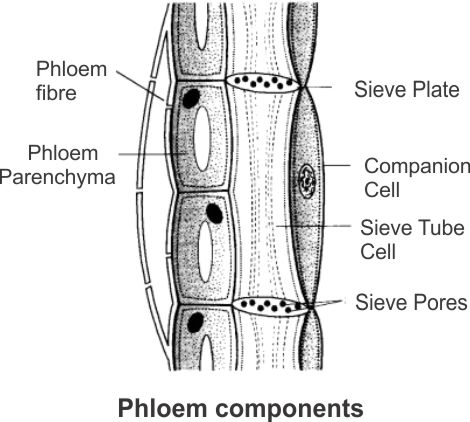
- Transport Function:
- Xylem transports water and minerals from roots to aerial plant parts (upward movement).
- Phloem transports sugars and other organic molecules from source to sink (bidirectional movement).